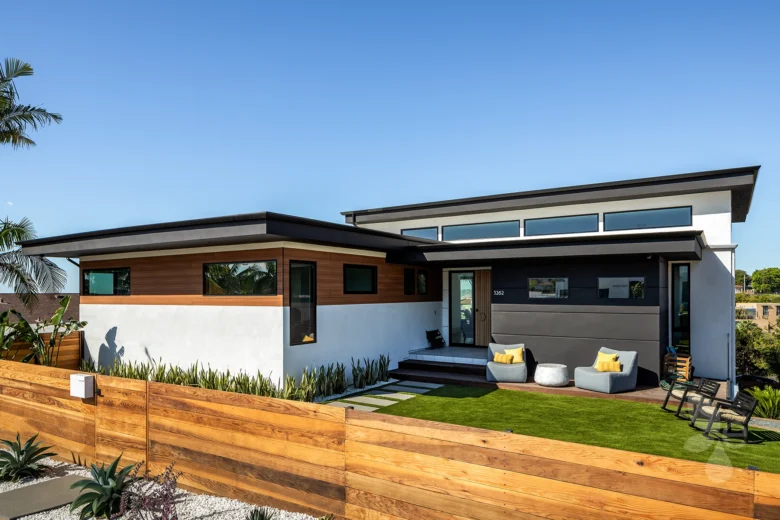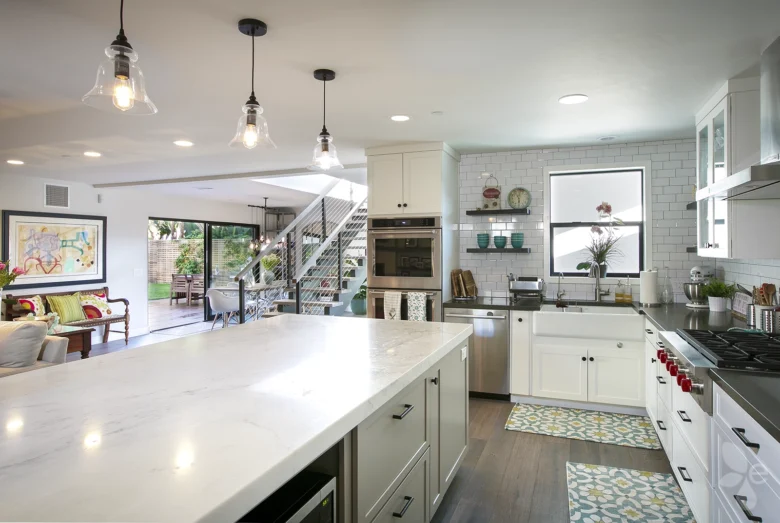Feeling overwhelmed? Don’t worry — we’ll help you navigate the various types of tile available for flooring and other applications, so you can choose the option that suits both your project and your budget.
1. Ceramic Tiles
Ceramic tiles are among the most popular types of tile, mainly due to their versatility for a wide range of applications. They’re manufactured from clay materials that are quarried, prepared, and then formed into a mold.
The appeal of ceramic tiles comes mostly from their increased durability, which makes them ideal for any room in the house, such as the bathroom, kitchen, and hallway. They’re also very easy to install and clean, and they are available in an extremely wide variety of styles. Ceramic tiles can be glazed or unglazed. While unglazed tiles can give an artistic, rustic finish, glazed tiles offer more protection, making your floor far more durable.
If you’re on a budget, then you’ll likely find ceramic tiles far more affordable compared to other types of tile (up to 60 percent cheaper than porcelain tiles).
We recommend: Check the ceramic tile lot number for consistency to make sure the end result is clean and uniform.
2. Porcelain Tiles
The second most popular type of tile, porcelain tile is known for its ability to emulate natural stone, wood, or bricks, minus the maintenance these materials would normally require. As an all-purpose tile, porcelain tile comes in a wide array of styles, designs, and colors, thus offering greater versatility when building or renovating your home.
In terms of applications, porcelain tiles are best used in the bathroom and kitchen, as well as in any high-traffic areas, like hallways. If you’re looking to redesign an outdoor space, porcelain tiles are a great choice as they don’t freeze, fade, or crack.
The biggest disadvantage of porcelain tiles is the tricky installation, as they require an adhesive when you lay them down. This can make DIY jobs a little more difficult.
3. Glass Tiles
The special reflective quality of glass tiles makes them a minimalist but vibrant choice for any interior space. They’re also an excellent alternative to natural stone tiles, thanks to their stain resistance.
Glass tiles can be used in larger spaces and paired with other tiles as well — for example, mosaic tiles. Moreover, they can withstand cold, water, and sunlight, so you can use them for outdoor projects too.
If you’re particularly concerned with cleaning and maintenance, you’ll definitely appreciate the low upkeep of glass tiles. Red wine can be easily wiped up without leaving any stains.
However, you should keep in mind that glass tiles will chip quite easily along the edges, which is why you shouldn’t use them in high-traffic areas such as kitchens and bathrooms. They’re best used in smaller applications with less traction, like the fireplace, gently used tabletops, or kitchen backsplash.
4. Cement Tiles
While cement tiles are experiencing a bit of a boon in modern interior design, they have been around since the 19th century. Cement tiles are particularly attractive because of their porous surface, which can develop a patina over time that enhances their pattern. Similarly, if any fading or discoloration occurs, cement tiles can be sanded and resealed to bring back their initial vibrancy.
These types of tiles is very difficult to lay and requires resealing once a month to preserve its beauty. Because they’re very prone to fading, cement tiles should be used in low-traffic areas and preferably in small quantities (unless you’re happy to spend more time on resealing them every month). Consider also how much sunlight the area will receive.
5. Marble Tiles
Offering high aesthetic value, marble tiles are made from an extremely durable stone (marble) that exists in almost every possible color due to the variability of component minerals. If you’re looking to upgrade any space in your house, laying down marble tiles will add instant elegance and beauty, as well as texture and depth, thanks to marble’s veined appearance.
Despite its extraordinarily durable nature, marble requires a lot of care to maintain its pristine look. And like other stone tiles, it is very susceptible to staining, scratching, and etching. Unless sealant is applied, it’s best to use marble tiles sparingly and only in low-impact and decorative areas, such as shower flooring, backsplashes, and columns.
Do not use marble tiles for exterior flooring or landscaping, as they are prone to scratching and etching.
6. Mosaic Tiles
If you’re looking to flex your creative interior design muscles, then mosaic tiles might be just perfect for whatever project you have in mind. Mosaic tiles usually come in small tiles, often square, that are laid together to create a larger effect for a bold visual impact. They can be made from glass, stone, ceramic, as well as other materials.
Due to their availability in a wide range of shapes, colors, styles and sizes, mosaic tiles are especially great as accents for walls and floors. They’re ideal for a wide variety of applications, such as kitchen and bathroom counters, showers, bathroom floors, outdoor areas, and backsplashes.
You need to be extra careful with these types of tile because your chosen design can look dated quickly. That’s why mosaic tiles should be chosen to seamlessly integrate with the rest of the room where they’re installed in a timeless design.
7. Granite Tiles
Yet another type of stone tile, granite tile has a feel and look similar to marble. Granite is a type of igneous rock resulting from cooling magma or lava solidifying, and it often features natural flecks and speckled minerals. It is distinguished by its hardness and high density, which makes it an excellent choice for secondary spaces where performance and a lower cost are a priority.
Granite tiles are also a cheaper alternative to marble tiles, so you might actually consider them if you’re on a budget. Once polished, granite resists scratching and etching well, so it can be used in high-traffic areas such as kitchens and bathrooms.
8. Limestone Tile
For spaces that call for an authentically rustic look filled with natural tones and shades, limestone tile is your best option. Once installed, limestone tiles will add an earthy look to any room, which is in many ways reminiscent of ancient architecture and design.
Limestone is durable but soft, and it can be cut and shaped into specific patterns and styles. It is best used for floors, walls, showers, and bathroom counters. You can even use it for outdoor spaces, such as patios, to give them a nice “finished” look.
One thing to keep in mind is that limestone is a highly porous rock that requires frequent resealing to maintain its durability and beauty for long.
Cleaning limestone tiles isn’t particularly easy, either. Only use cleaning products with a neutral pH, and avoid vinegar- and citrus-based products, as their high acidity can ruin the stone.
9. Travertine Tile
Much like limestone, travertine tile delivers a natural, earthy aesthetic ideal for creating rustic spaces. Its soft palette offers beautiful neutral tones, including beige, tan, and even gray, and its swirling patterns produce an elegant effect that makes a statement in any room.
Travertine is, in fact, a byproduct of natural hot springs, artesian springs, and caves with a porous surface. Its varying colors are the result of air bubbles and organic matter inside the rock, which also cause pits and a rough texture.
Because travertine is naturally slip-resistant, you can use it for walkways, bathrooms, pool decks, and any other applications where water is present. However, just like the other stone tiles mentioned above, it is easily impacted by stains and traction, so it requires quite a bit of upkeep. Regular resealing every 8-10 years will also result in longer-lasting floors and walls.
If you can’t dedicate the extra time and effort to maintaining travertine but you like its unique visual appeal, you can use it in lower-traffic areas of your home.
10. Quarry Tiles
While its name might imply it comes from a quarry, that is not the case. Quarry tile is made with ground minerals, such as clay, shale, and feldspar, which are mixed together and baked at 2,000+ degrees — a process not dissimilar to brick, only quarry tile is much stronger. Because they’re fired at such high temperatures, quarry tiles are nonporous, dense, and water-resistant, so they can be used in areas where water is present without issue.
Another benefit of these types of tile is that it doesn’t need to be sealed to maintain its durability. You can choose to glaze it or leave it in its natural finish if you prefer a more rustic look.
Despite its density and resistance, quarry tiles tend to be easily stained, so they’re not ideal in the kitchen. Like limestone, they’re slip-resistant and can be used in high-traffic areas, such as bathrooms.
11. Metal Tiles
Metal tiles give any space a modern and chic look, but they’re also pricier and may not appeal to those on a budget. Their durability and beautiful aesthetic should not be overlooked, though — if you’re looking for types of tile that will certainly withstand the test of time, metal tile is your best bet.
One important aspect you shouldn’t disregard is that metal is very susceptible to scratches and will likely show signs of scratching almost as soon as it’s installed. Many homeowners prefer this naturally occurring patina because it softens the crisp look of the metal. However, if this kind of finish isn’t what you’re looking for, you might want to consider a different type of tile altogether.
In terms of where to use metal tile, it’s generally great for work surfaces in the kitchen, bar, or utility rooms. It does tend to be slippery, so it’s best not to use it for baths or outdoor applications.
12. Resin Tiles
Another option for creative homeowners and DIYers, resin tiles allow you greater creative freedom, as you can combine the styles you want. You can even create your own tile patterns, including 3D, if you want to imitate the look of water and stones.
There are two disadvantages of resin tiles you should be aware of. First, is this tile’s susceptibility to chipping. Second, is its tendency to yellow over time, especially if exposed to sunlight. That’s why you’d be better off using resin tiles as flooring for water areas, like the bathroom or mudrooms.
You also have the option to use resin tiles as wall and floor accents, or for backsplashes.
Let Us Help You Choose the Best Types of Tile for Your Project
At Eco Minded Solutions, we offer a range of home improvement and remodeling services that add value to your home and also greatly enrich your day-to-day life. From designing the layout to helping you choose the best types of tile for your bathroom, kitchen, living room, or bedroom, we’re dedicated to creating spaces you’ll love.
With our extensive experience in the home improvement industry, we’re able to make the best recommendations for all types of materials to be used as part of your remodeling project. Contact us today to discuss the best types of tiles for your home.


